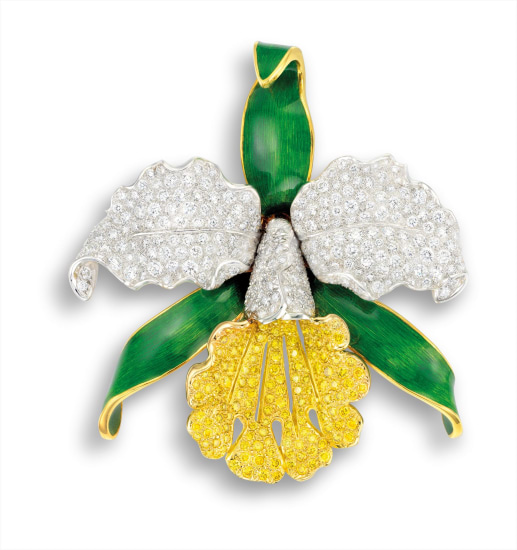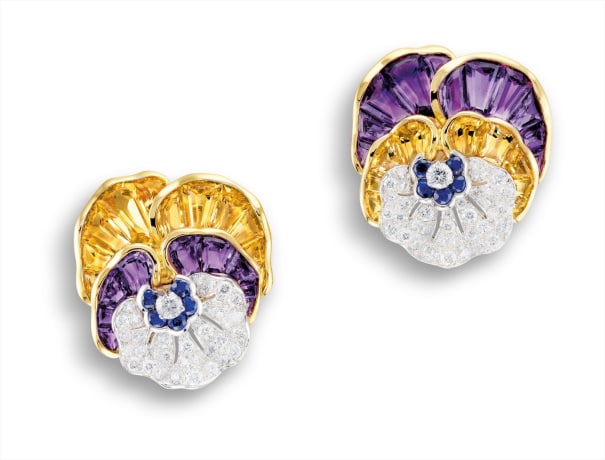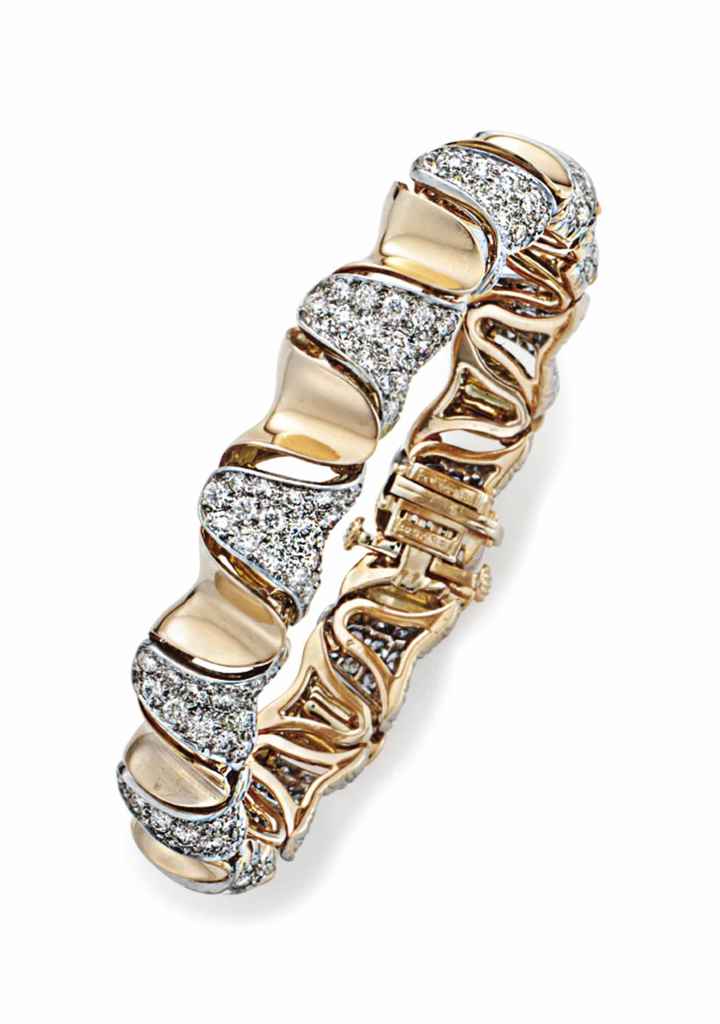Oscar Heyman
Manufacturer: Oscar Heyman Year: 1921 Movement No: 25525C Case No: 104'841 Material: Platinum, diamonds, rubies and emeralds Calibre: Mechanical, 8'', 18 jewels Bracelet/Strap: Platinum, diamond, ruby and emerald-set Oscar Heyman bracelet, 155 mm. maximum length Clasp/Buckle: Platinum, diamond and emerald-set Oscar Heyman folding clasp Dimensions: 21 mm. wide Signed: Case signed Oscar Heyman, movement signed Audemars Piguet Accessories: With Oscar Heyman photocopy of the original design drawings, fitted presentation box and outer packaging. Catalogue Essay Oscar Heyman & Bros., better known in the industry as the jeweler’s jeweler, rose to prominence in the 1920s after Oscar and his brother, Nathan Heyman, immigrated to the United States from Latvia in 1906. Six years later, the entire family emigrated over and the brothers formally opened their workshop for business. Having previously apprenticed at their uncle’s Fabergé workshop, the brothers were well equipped to indulge the tastes of New York society. Oscar and Nathan’s ability to work in platinum, a relatively new metal at the time, distinguished them from contemporaries, and quickly garnered the attention of prestigious jewelers. The brothers eventually worked as bench jewelers for Cartier, Van Cleef & Arpels, Shreve, and J.E Caldwell among others. In fact, Oscar Heyman & Bros. was the first American workshop to master Van Cleef & Arpel’s iconic mystery setting. They were also commissioned by Cartier in the late 1960s to design and set the infamous Taylor Burton diamond, given to Elizabeth Taylor. With their illustrious and prestigious clients, it comes as no surprise that Oscar Heyman’s craftsmanship is second to none. Indeed, the movement of the present watch is manufactured and signed by Audemars Piguet, which further provides a double seal of approval and confidence. This bracelet watch was designed by Oscar Heyman in the early 1920s in the Art Deco style of ‘Tutti Frutti’, which was in vogue for the 1920s, and, as some may argue, even more in style today. ‘Tutti Frutti’ jewelry was inspired by the design, colour and setting of Indian gem-set jewelry and Egyptian Revival. Cartier and other leading jewelry designers had a very original approach to the world of ancient Egypt, which was gripping society in the early 1920s. Drawing inspiration from distant lands, jewelers had to look at different ways to tempt their clients to buy after the first world war. Egyptomania of Art Deco materialized in buildings, decorations and elegance. The Art Deco period produced new audacity through stunning colour combinations that mixes diamonds, emeralds, rubies and sapphires and engraved with floral motif, producing eye-catching creations. This fascination with Egypt was stimulated by account of travelers and artists, who were taking parts in excavations in Egypt, which was widely reported in the press and the discovery of Tutankhamun in 1922, generated even further excitement in society and helped secure the Art Deco period and the love for Egyptian revival through magnificent jewelry creations, such as the present Oscar Heyman bracelet watch. The design of the present lot is distinguished by the present bracelet’s brilliant diamonds, carved rubies in the form of scarabs, baguette emeralds and unique claw setting. The hinged cover is further inspired by the Maharaja’s jewels, with a central marquise diamond flanked by two brilliant cut diamonds on either side and further surrounded by two rows of brilliant cut diamonds. This Oscar Heyman bracelet watch is truly a sight to behold and must be considered one of their most important bracelet watch creations. It can be best described as a superlative watch of the 1920s Art Deco period, merging the finest craftsmanship with one of the most prestigious watchmakers of the period. It is unknown whom they commissioned Oscar Heyman to create this masterpiece, however, the imagination runs wild at the thought of the princess, whom would be worth
Oscar Heyman
Manufacturer: Oscar Heyman Year: 1921 Movement No: 25525C Case No: 104'841 Material: Platinum, diamonds, rubies and emeralds Calibre: Mechanical, 8'', 18 jewels Bracelet/Strap: Platinum, diamond, ruby and emerald-set Oscar Heyman bracelet, 155 mm. maximum length Clasp/Buckle: Platinum, diamond and emerald-set Oscar Heyman folding clasp Dimensions: 21 mm. wide Signed: Case signed Oscar Heyman, movement signed Audemars Piguet Accessories: With Oscar Heyman photocopy of the original design drawings, fitted presentation box and outer packaging. Catalogue Essay Oscar Heyman & Bros., better known in the industry as the jeweler’s jeweler, rose to prominence in the 1920s after Oscar and his brother, Nathan Heyman, immigrated to the United States from Latvia in 1906. Six years later, the entire family emigrated over and the brothers formally opened their workshop for business. Having previously apprenticed at their uncle’s Fabergé workshop, the brothers were well equipped to indulge the tastes of New York society. Oscar and Nathan’s ability to work in platinum, a relatively new metal at the time, distinguished them from contemporaries, and quickly garnered the attention of prestigious jewelers. The brothers eventually worked as bench jewelers for Cartier, Van Cleef & Arpels, Shreve, and J.E Caldwell among others. In fact, Oscar Heyman & Bros. was the first American workshop to master Van Cleef & Arpel’s iconic mystery setting. They were also commissioned by Cartier in the late 1960s to design and set the infamous Taylor Burton diamond, given to Elizabeth Taylor. With their illustrious and prestigious clients, it comes as no surprise that Oscar Heyman’s craftsmanship is second to none. Indeed, the movement of the present watch is manufactured and signed by Audemars Piguet, which further provides a double seal of approval and confidence. This bracelet watch was designed by Oscar Heyman in the early 1920s in the Art Deco style of ‘Tutti Frutti’, which was in vogue for the 1920s, and, as some may argue, even more in style today. ‘Tutti Frutti’ jewelry was inspired by the design, colour and setting of Indian gem-set jewelry and Egyptian Revival. Cartier and other leading jewelry designers had a very original approach to the world of ancient Egypt, which was gripping society in the early 1920s. Drawing inspiration from distant lands, jewelers had to look at different ways to tempt their clients to buy after the first world war. Egyptomania of Art Deco materialized in buildings, decorations and elegance. The Art Deco period produced new audacity through stunning colour combinations that mixes diamonds, emeralds, rubies and sapphires and engraved with floral motif, producing eye-catching creations. This fascination with Egypt was stimulated by account of travelers and artists, who were taking parts in excavations in Egypt, which was widely reported in the press and the discovery of Tutankhamun in 1922, generated even further excitement in society and helped secure the Art Deco period and the love for Egyptian revival through magnificent jewelry creations, such as the present Oscar Heyman bracelet watch. The design of the present lot is distinguished by the present bracelet’s brilliant diamonds, carved rubies in the form of scarabs, baguette emeralds and unique claw setting. The hinged cover is further inspired by the Maharaja’s jewels, with a central marquise diamond flanked by two brilliant cut diamonds on either side and further surrounded by two rows of brilliant cut diamonds. This Oscar Heyman bracelet watch is truly a sight to behold and must be considered one of their most important bracelet watch creations. It can be best described as a superlative watch of the 1920s Art Deco period, merging the finest craftsmanship with one of the most prestigious watchmakers of the period. It is unknown whom they commissioned Oscar Heyman to create this masterpiece, however, the imagination runs wild at the thought of the princess, whom would be worth



.jpg)










.jpg)
Try LotSearch and its premium features for 7 days - without any costs!
Be notified automatically about new items in upcoming auctions.
Create an alert